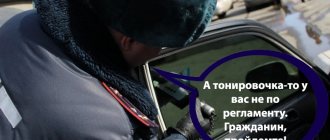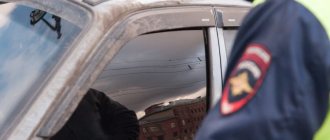Car owners love tinted front windows, as it reduces the amount of sunlight in the cabin and the strength of the rays of oncoming cars. Tinted windows further improve the appearance of the car and provide some protection from prying eyes. Only the President and the head of the Cabinet of Ministers can move with full tinting. For other residents, the standards specified in the legislation apply. What tinting is allowed on front windows, and what kind of tinting the traffic police patrols find fault with, we will look at in the article.
What kind of tinting is allowed on the windshield: we understand the standards
At the beginning of 2015, the level of permeability into the cabin through the windshield was regulated by GOST 5727-88. During its operation (since the early 90s), 4 amendments were made. The latest version has been in effect since 2002. According to the law, tinting on car door windows and windshields must meet the following requirements:
- light transmittance of windshields is 75% or higher. It was allowed to install a light-protective strip in the frontal part; its width was also regulated by GOST (calculated using a formula), more often it was less than 15 cm. The calculation was based on the height for unhindered operation of the wipers, the required viewing angle and regulatory zones;
- non-windshields, referred to as so-called, can be tinted to protect against rays by no more than 30%;
- For other non-windshields, the standards do not have clear recommendations.
Car tinting according to GOST
Starting from January 1, 2015, adjustments were made to the technical regulations; now tinting is standardized by GOST 32565-2013. Legislation has reduced light transmission standards to 70% (5% lower than the previous figure). Thanks to changes in regulations, tinting with athermal film, which has been especially popular in recent years, has been legalized.
Similar requirements are included in another document - the technical regulations of the Customs Union. When crossing the border with the countries of the Customs Union, you don’t have to worry about fines or problems at checkpoints.
It is worth adding to the answer what kind of tinting can be used to tint the front windows, since the innovation sets a rigid size for the shading strip, now it is 140 mm. No standards have been developed regarding light transmission. Additionally, the side windows have been divided into:
- type 1 – create a view from the front;
- type 2 - create rear visibility.
Distribution into categories is made based on the principles of geometric distribution of the body. The “R point” (so-called) should be installed on the driver’s seat from the factory. By drawing a vertical line through a point perpendicular to the longitudinal median plane of the car, it is possible to divide the car into 2 parts. The front half with glass belongs to the first category, and the second to class 2.
Light transmission of glass according to GOST
The new standards have not changed the parameters of what kind of tinting can be used to tint the front windows - the amount of light after measurement should be 70% or higher. If the design of the car is equipped with 2 external rear-view mirrors, any film can be applied to the glass of category 2, since the corresponding standards have not been developed.
The traffic regulations allowed the installation of curtains on the rear window of a car or the side windows of a bus. It turns out that the permissible tinting of the rear window reaches complete impenetrability.
What car tinting is allowed?
As of March 2021, the rules for tinting car windows are as follows:
- Tinting of any car windows is allowed, but this rule is valid only if the light transmittance of the part is at least 75%.
- According to the law on tinting, the rear window of a vehicle, as well as its rear side windows, can be 100% tinted.
- According to the law on tinting, the car owner has the right to stick a transparent tinting film on the top of the car's windshield for sun protection.
- The use of mirror film, according to the law on tinting, is prohibited in any form or form.
Light transmission standards for car windows
These rules raise a number of questions for car owners. For example, everyone is interested in what is the maximum width of the strip of light-protective film that can be glued to the top of the windshield.
If we are talking about a passenger car, then the width of the protective strip should not exceed 14 centimeters. However, it should be noted that inspectors always measure the width of this strip in three places (as stated in the law on tinting), and then calculate the arithmetic average of the three values.
Light protection strip on the windshield
Also quite common is the question of whether a driver will be subject to sanctions under the law on tinting if he covers the windows of his vehicle with a film whose light transmittance is exactly 70%. Unfortunately, it will most likely get hit. This is due to the fact that clean car windows themselves have a certain percentage of light transmittance. As a rule, it ranges from 95 to 97% percent. Accordingly, after covering the glass with a film, the light transmittance coefficients of both materials are multiplied and make the coating darker.
So if you don’t want to be fined for violating the law on tinting, always leave a margin of a few percent when tinting your car - this will definitely protect you from non-compliance with traffic rules.
It should also be taken into account that most light transmittance measuring instruments used by law enforcement officials may be subject to inaccuracy, which is much more likely to occur if used incorrectly. Therefore, traffic police officers, according to the law on tinting, must take at least 3 measurements in different parts of the glass, and then calculate the arithmetic average.
Permitted tinting of car windows: what is allowed and what is not?
With changes in legislation, the state actually legalized front window tinting using films. GOST uses the designation of glass with an acceptable polymer layer, but does not mention film. Tinting must comply with 3 documents: traffic rules, technical regulations of the vehicle and GOST 32565. Now we can confidently answer whether it is possible to tint a windshield - yes, both using spraying and film.
Especially a lot of ambiguity has arisen regarding mirror tinting. GOST does not directly indicate what kind of tinting can be glued to the front windows, but CU regulations clause 4.5 prohibits the installation of auto glass with a mirror coating. Additionally, the ban from the standard continues to apply since 1993, which establishes a list of rules for admitting vehicles to operation. Tinting side windows or rear windows with mirror film leads to the risk of an accident, because the light is reflected from the coating and blinds.
It is precisely established what percentage of tinting is allowed on front windows - 70% light transmission and more. For the sides, the percentage is regulated similarly - 70%. The permitted coefficient for the rear windows is not specified, as is the case for the rear doors, but when creating a darkness of less than 60%, the film somewhat reflects the light, creating a mirror effect. It is preferable to use a darkening level of 60% or higher in combination with curtains.
Car tinting with mirror film
Materials and tools
Car window tinting is a simple process that you can do yourself. However, to achieve a good result, you need to be careful and use quality materials.
Film tinting tools:
- industrial dryer;
- lighting equipment or bright lamp;
- sharp stationery knife;
- rubber spatula for smoothing tint on glass;
- a set of soft microfiber cloths;
- soap solution for tinting;
- spray with air pumping for uniform spraying of the composition.
When varnishing, you need to dismantle the part or carefully close the interior trim using rags, newspapers and masking tape. A degreasing mixture used to treat the surface before painting can harm door cards, so they must be protected with a thick cloth.
To install tinted curtains or finished glass at home you will need:
- screwdrivers;
- spanners.
All necessary clips and hooks for curtains are secured in hidden places using the included latches and screws.
When tinting car windows yourself, you should be careful not to let the liquid get into your eyes.
Athermal tinting: allowed or not?
It's no secret that in the absence of film the car gets very hot. Even the presence of climate control does not show sufficient efficiency; passengers sweat.
Thanks to the inclusion of metal particles in the coating on glass, it is possible to achieve several advantages:
- the interior heats up more slowly;
- the need to use air conditioning is reduced;
- fuel consumption decreases;
- the atmosphere improves due to reduced gas emissions.
With strong darkness, the same effects occur, but there will be problems with the traffic police. When choosing what kind of tinting you can tint your front windows, you should take a closer look at the athermal material. When using athermal film, the interior remains clearly visible, the amount of light transmitted is about 90%, but it effectively reflects ultraviolet and infrared radiation, which leads to heating.
If you glue an athermal film to the windshield, you can improve the characteristics of the glazing and experience a number of advantages:
- gluing film is permitted by GOST, since the permissible percentage of 70% is observed, usually higher - 80-90%;
- the interior does not experience strong heating from the sun, as a result, the interior retains its new appearance for a long time;
Athermal tinting Lada Vesta
- at night the driver is protected from being blinded by oncoming cars;
- tinting improves the aesthetic perception of the car due to the transfusion effect;
- tinting helps to reduce the visibility of the interior from the outside.
An alternative option is to stick on one of the varieties of athermal material popularly called “chameleon”. The material changes the level of darkness depending on the lighting; on a clear day the film protects more, and on a cloudy day it blocks out less light. The selection rules are the same - the main condition is to maintain a permeability of at least 70%.
Why has the permitted percentage of tinting on front windows been reduced in the new GOST?
The light transmission of clean and completely new glass is not 100%, the maximum is 85%. If you take a standard film, most often the light transmission rate is 75%. If we take both indicators into account, the result will be: 0.85 * 0.75 = 0.64%. It turns out that film, by old standards, was always illegal.
The highest coefficient for the new film is 80-90%. According to basic calculations, installing film on the front glass was initially an illegal procedure. Taking into account the fact that with use the indicator decreases to 75-80%, the film always led to exceeding the normal limits. Light transmission can only be achieved by installing a light-colored film (90%) on new glazing (85%).
Formula: 0.9*0.85 = 76.5%.
Car front window tinting
In reality, it was almost impossible to tint the front car windows to achieve 75%. The indicator was always below the norm. For this reason, the percentage was reduced in GOST 32565-2013.
Tinting of the front side windows, as well as the windshield, is allowed, but a preliminary calculation is made of how much light will pass through, taking into account the indicator of the film, glass and deterioration during operation.
How to check the light transmission of car windows
The level of light transmission of glass is checked using a special device - a taumeter. It is worth noting that when checking the tint, the police officer must follow a number of rules.
- Light transmission is checked only at stationary police posts.
- The test cannot be carried out during rain and high air humidity from 45 to 80%.
- You can only check on a clean and dry surface.
- For reliability, you need to check in three different places.
- Before monitoring light transmission, the law enforcement officer must measure the level of atmospheric pressure, which should not exceed 795 mm.
- Only a police officer with a special mark on his license can check the tinting of the glass.
- The taumeter must have certificates and a seal.
- When measuring tint, the air temperature should not exceed 25 degrees.
Some motorists believe that checking cannot be done at night, but this is not true. In fact, there is no time limit; you cannot check the windows only in dirty and slushy weather.
How to avoid being included in the list of those fined?
The most effective way to prevent a fine from being issued is to remove the tint completely, but this is an extreme option. A more conservative method is to lower the front side windows, but this can only be used in the summer.
The main problem is that full compliance with GOST standards is not 100% protection from receiving a fine. The risks are especially high for owners whose degree of tint is within acceptable limits, but approaches 70%. Devices for measuring light transmittance have operating errors; there is a high probability that the device will determine the glass as not meeting the standards.
There is an option to tint the glass with a light transmittance of 70-72% and avoid fines - take the permit with you. If there is an expert opinion, the traffic police should not find fault, but there are still no guarantees.
Fine for tinting car windows
The best way to protect yourself from a fine is to leave a gap of a few percent, then the suspicions of the traffic police will definitely be dispelled. If employees insistently demand measurements, your task is to demand careful compliance with all standards for using the device. Before checking, the air temperature and humidity level are determined. If the threshold is exceeded, the device will not provide reliable results.
When receiving readings that violate the requirements, the driver has the right to request a repeat measurement using another device. If the employee does not agree to repeat the procedure, a record of this is made in the protocol. Additionally, you can clarify the series and number of the device, and then appeal the results during the legal process. If the outcome is successful, an independent examination is appointed.
Penalty for incorrect tinting
Every driver should know the smallest details of imposing a fine for improper tinting of a car in order to be able to protect himself from illegal actions by traffic police officers:
- A fine is imposed only upon violation of GOST rules, regardless of the degree of violation.
- “Removable” tinting in the form of curtains and blinds on car windows does not exempt the violator of GOST on tinting from a fine.
- The law adopted in 2021 states that if a fine is paid within 20 days from the date of the decision on punishment, it is reduced by 50%. The law also applies to other motorist violations.
- The level of light transmittance of the film is indicated without taking into account the factors that influence changes in these parameters, because after applying tinting to the glass, its light transmittance may decrease significantly. With prolonged use of the film, it is rubbed off by the wipers, which also worsens the light transmission parameters.
This is interesting: How to make a phone holder in a car with your own hands? 3 simple designs
Previously, the use of incorrect tint was punishable by removal of the license plate and a ban on its use until the violation was corrected. Currently, such measures are not used, however, it is necessary to adhere to the law.
There are certain restrictions on the frequency of imposing fines. It is important to pay attention to the fact that the police officer, when drawing up a report, indicates the exact date and time. The law does not allow another fine for tinting to be issued less than 24 hours after the previous one. If 24 hours have not passed and the driver is stopped by another law enforcement officer, he must be presented with the existing protocol.
Only a court can impose additional penalties in the form of a fine or arrest. If you disobey the law and drive a car with incorrect tint after receiving a fine, the court may rule on deprivation of your license.
The fine for tinting front windows according to GOST in 2021 is 1,500 rubles. For repeated violation - 5,000 rubles. You can try to prevent a fine from being issued in the following ways:
- The tint can be removed right in front of the police officer, thereby avoiding fines.
- If, while checking the level of light transmittance, a police officer violates at least one of the above rules, he must be informed. In case of non-compliance with the rules for tinting control, the decision can be appealed in court.
- If the police report is completed incorrectly, you must immediately inform the officer about the error. There is a chance that the law enforcement officer will not draw up the document again and will release the driver.
- Ways to legally tint car windows.
What instruments measure the light transmittance of glass?
Light transmission measurements are carried out by an inspector. It is worth considering that the results always have an error, it is mostly insignificant, but if the rules of use are not followed, the deviation may increase. The results are affected by temperature, humidity and pressure.
The traffic police are armed with several types of devices:
- "Light". The light emitter and receiver are equipped with magnets, which makes the device easier to use. The rules indicate the need to take measurements at least 3 times. The real indicator is the arithmetic average of all measurements. The advantage of the device is its resistance to low temperatures;
Tonic device for checking tinting
- "Tonic". Both detectors have to be held manually, which often leads to errors. A mandatory requirement for correct measurement is strict coincidence of the marks on both sides of the device. Operates at temperatures from -10°C to 40°C;
- AKL-2M. Violation of the results occurs when the rubber gaskets do not fit tightly. The use of the device is permitted only at temperatures above 10°C.
The principle is the same in each case: the emitter is installed on one side, and the receiver on the other. When applying both elements to each other, the indicator should be 100%. If there is glass between them, the result will always be lower.
Correct results for each device are only obtained when attached to dry glass.
How to properly tint your front windows?
Most new cars come from the factory with windows that have about 80% light transmission. There is no need to apply film on modern cars. If you glue a film with a permeability of 90% on top of it, the indicators will already be on the acceptable side.
Any tint can be applied to the rear windows. To comply with the standards, it is recommended to leave the process of gluing and selecting film in the hands of professionals. At the tinting station, they also make sure that the permeability meets the standards.
Recommendations
If the applied film violates technical standards, it should be removed. There are several ways to remove old tint. To simplify the procedure, use a soap solution and a hair dryer.
If you want to tint your car, electric tinting may be a solution. It changes the level of light transmission depending on the user's wishes. The solution is convenient and effective, but expensive. An alternative is chameleon tinting; it independently changes permeability and costs less.
When choosing types of tinting, athermal film for cars is preferred; it prevents strong heating and maintains high light transmittance.










